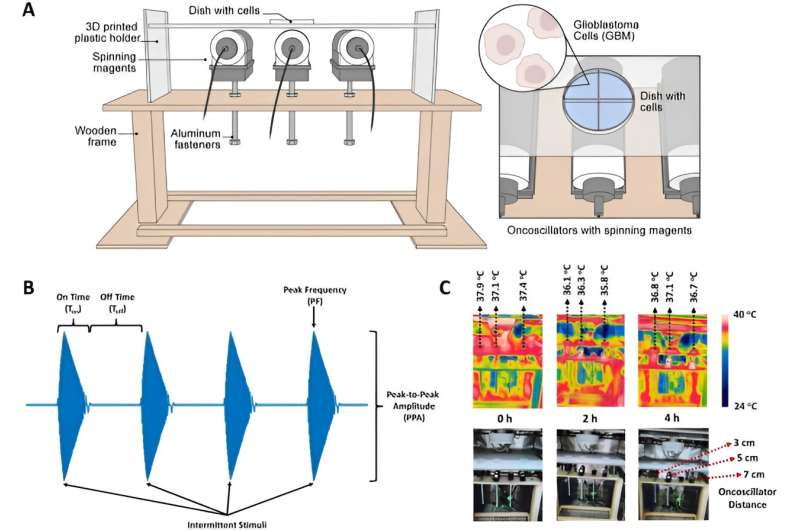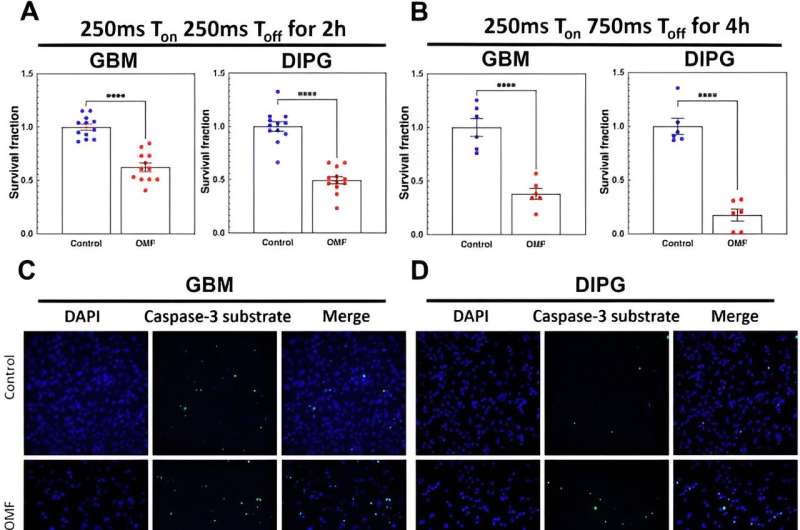November 13, 2023 feature
This article has been reviewed according to Science X's editorial process and policies. Editors have highlighted the following attributes while ensuring the content's credibility:
fact-checked
peer-reviewed publication
trusted source
proofread
Magnetic field patterns found to cause oncolysis via oxidative stress in glioma cells

Anticancer treatment strategies increasingly seek to raise reactive oxygen species (ROS) levels, cause macromolecular damage, and kill cancer cells. Electromagnetic fields can elevate intracellular reactive oxygen species to cause cancer cell death leading to the development of a new portable, wearable electromagnetic field device that generates spinning oscillating magnetic fields (sOMF) to selectively eliminate cancers.
In a new report published in Scientific Reports, Shashank Hambarde, and a team of scientists in neurosurgery in the U.S., characterized precise configurations and timings of spinning oscillating magnetic fields to produce cytotoxicity due to a critical rise in superoxide levels in two types of human glioma cells.
The antioxidant Trolox reversed the cytotoxic effect of spinning oscillating magnetic fields on glioma cells to indicate the role of reactive oxygen species in producing the onset of cancer. The outcomes highlight the link between the physics of magnetic simulation and anticancer action to facilitate a new and safe non-invasive device-based treatment strategy to attenuate several glioma types.
Regulating the tumor microenvironment with reactive oxygen species
Reactive oxygen species play a significant role in regulating normal cellular processes, including developmental cell proliferation, differentiation, cell death, and immune defense mechanisms, as well as cell plasticity.
The role of reactive oxygen species is significant during cancer cell proliferation, and tissue invasion, with attributes provided to cellular aging and neurodegeneration.
Cancer cells have high levels of reactive oxygen species due to increased oxidative metabolism and dysfunctional mitochondria. Abnormally high levels of reactive oxygen species can cause cell apoptosis, therefore increased reactive oxygen species in cancer cells can be an adequate treatment strategy.
Stimulating with an electromagnetic field
Aside from drugs, stimulation by electromagnetic field generating devices can raise the reactive oxygen species level in cancer cells to induce cell death of malignant tumor cells in vitro.
While these devices have shown safety and efficacy for integration in mouse tumor xenograft models, large patient trials remain to be conducted. Human cancer cells have produced variable results to show the increase and decrease in reactive oxygen species levels.

Hambarde and colleagues designed and developed an oncomagnetic device to precisely regulate all physical parameters of spinning oscillating magnetic fields, exposed both in vitro and in vivo, to produce an optimum increase in reactive oxygen species levels.
In this work, the scientists varied the physical parameters used to define the tumor microenvironment. To accomplish this, they investigated the impact of varying the physical parameters of the spinning oscillating magnetic fields by producing active components of the device known as oncosillators in patient-derived glioblastoma and in diffuse intrinsic pontine glioma cells.
Mechanism of action
The interaction of weak and intermediate strength magnetic fields with the radical pair mechanism in the mitochondrial electron transport chain perturbed the electron transfer process to generate a superoxide. The electron transport chain membrane complex molecules were oriented in all directions and did not tumble unlike molecules in solution.
Hambarde and colleagues tested these predictions by using an experimental setup to stimulate glioblastoma and diffuse intrinsic pontine glioma cells, to quantify the fluorescence intensity of the superoxide indicator dye hydroethidine. During the experiments, the team generated an intermittent spinning oscillating magnetic field by using oncosillators to generate high levels of reactive oxygen species.
The scientists characterized the magnetic oscillations induced by a rotating magnet to indicate how field oscillations play a significant role to induce reactive oxygen species. They sent a current through the coil to generate a peak-to-peak amplitude of 5 mT, which they compared to a spinning magnet of an oncosillator, to deliver simulations for four hours.
The oncosillator significantly raised the reactive oxygen species levels in the microenvironments at all time points within the cancer cell types.
Outlook
In this way, Shashank Hambarde and colleagues tested the magnetic electron perturbation hypothesis to determine the effectiveness of a range of spinning oscillating magnetic fields (sOMFs) to induce superoxide components of reactive oxygen species in human glioblastoma cells and in diffuse intrinsic pontine glioma cells.
The scientists studied if the effects of stimulation with an optimized set of parameters produced high anticancer potency in standardized assays. Devices or methods to produce magnetic fields suited for anticancer studies included pulsed electromagnetic field generators, bio-electro-magnetic-energy regulation systems and low-frequency electromagnetic field delivering apparatuses, as well as the Therabionic device.
These instruments delivered magnetic fields with flux densities in the lower range. While some of these concepts raised the reactive oxygen species in cancer cells, their physical basis and underlying mechanisms remain to be explored.
This work additionally included a study of the compassionate use of oncomagnetic treatment in patients with end-stage recurrent glioma as a new and effective treatment strategy to address highly malignant and lethal carcinomas.
More information: Shashank Hambarde et al, Spinning magnetic field patterns that cause oncolysis by oxidative stress in glioma cells, Scientific Reports (2023). DOI: 10.1038/s41598-023-46758-w
© 2023 Science X Network


















